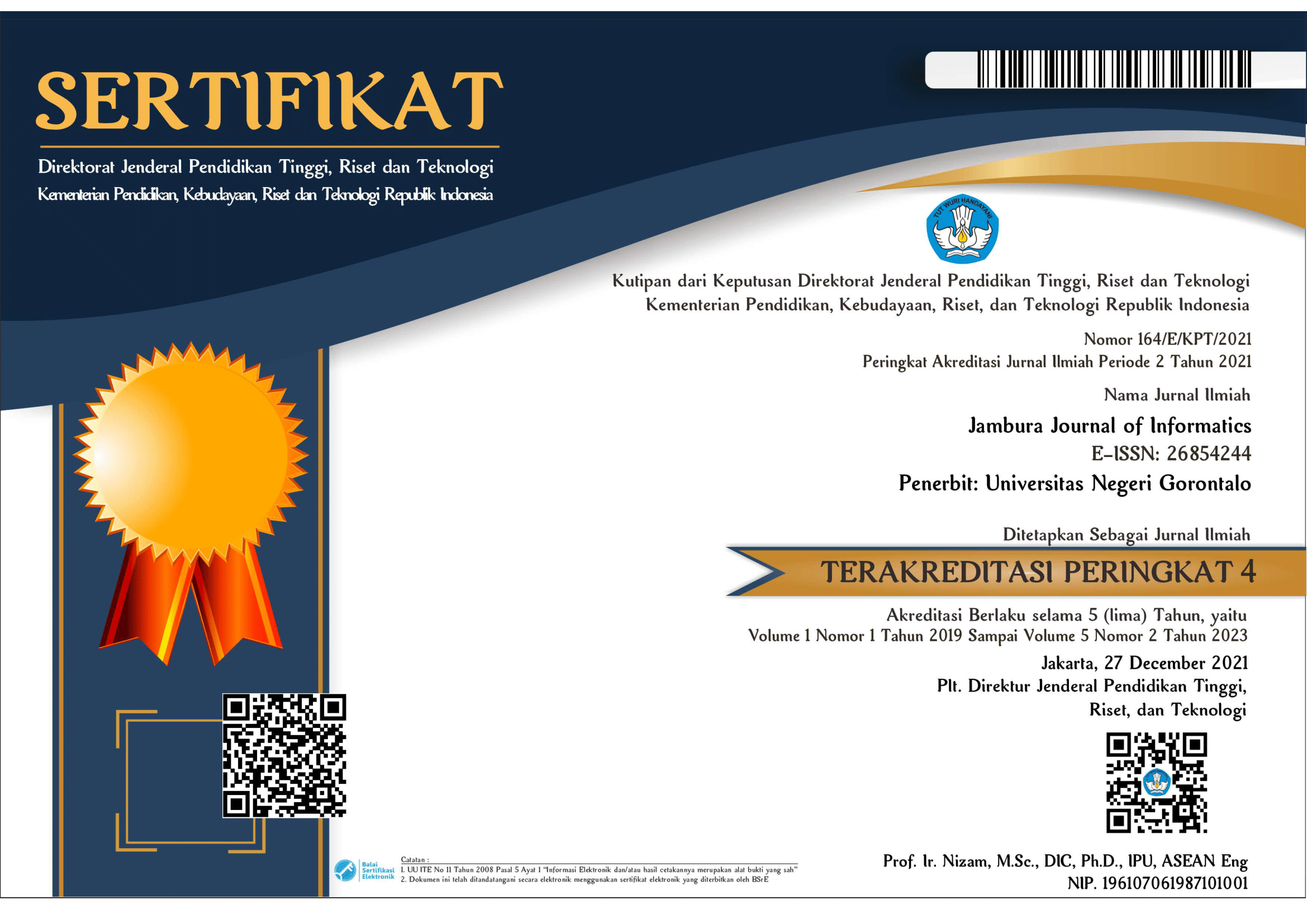Evaluasi Penerimaan dan Penggunaan Aplikasi Mobile Banking menggunakan Model UTAUT 2
Abstract
This study aims to identify factors in the UTAUT 2 model that significantly influence the acceptance and use of the XYZtouch mobile banking application in Gorontalo City. The research employed a quantitative approach with data from 129 respondents analyzed using PLS-SEM. The results reveal that of the seven independent variables in the UTAUT 2 model, only three variables significantly influence behavioral intention: social influence (β=0.133, p<0.05), hedonic motivation (β=0.153, p<0.05), and habit (β=0.374, p<0.001). Meanwhile, performance expectancy, effort expectancy, facilitating conditions, and price value do not have significant effects. Based on these findings, the study recommends the adoption of enhancement strategies focusing on strengthening social influence, developing the hedonic aspects of the application, and establishing usage habits. This research contributes to validating the UTAUT 2 model for the context of regional bank mobile banking in Indonesia.
Penelitian ini bertujuan untuk mengidentifikasi faktor-faktor dalam model UTAUT 2 yang secara signifikan mempengaruhi penerimaan dan penggunaan aplikasi mobile banking XYZtouch di Kota Gorontalo. Penelitian menggunakan pendekatan kuantitatif dengan data dari 129 responden yang dianalisis menggunakan PLS-SEM. Hasil penelitian menunjukkan bahwa dari tujuh variabel independen dalam model UTAUT 2, hanya tiga variabel yang berpengaruh signifikan terhadap behavioral intention, yaitu social influence (β=0,133, p<0,05), hedonic motivation (β=0,153, p<0,05), dan habit (β=0,374, p<0,001). Sementara performance expectancy, effort expectancy, facilitating conditions, dan price value tidak berpengaruh signifikan. Berdasarkan temuan ini, direkomendasikan strategi peningkatan adopsi yang berfokus pada penguatan pengaruh sosial, pengembangan aspek hedonis aplikasi, dan pembentukan kebiasaan penggunaan. Penelitian ini berkontribusi dalam validasi model UTAUT 2 untuk konteks mobile banking bank regional di Indonesia
Keywords
Full Text:
PDFReferences
Abdennebi, H. B. (2023). M-banking adoption from the developing countries perspective: A mediated model. Digital Business, 3(2), 100065. https://doi.org/10.1016/j.digbus.2023.100065
Alalwan, A. A., Dwivedi, Y. K., & Rana, N. P. (2019). Factors influencing adoption of mobile banking by Jordanian bank customers: Extending UTAUT2 with trust. International Journal of Information Management, 37(3), 99-110. https://doi.org/10.1016/j.ijinfomgt.2017.01.002
Andhika, I., Pratama, A. R., & Pratama, Y. (2023). Analysis of mobile banking acceptance in Indonesia using extended TAM (Technology Acceptance Model). Jurnal Teknologi Informasi dan Pendidikan, 16(2), 68–78. https://doi.org/10.24036/jtip.v16i2.626
Bagozzi, R. P. (2007). The legacy of the technology acceptance model and a proposal for a paradigm shift. Journal of the Association for Information Systems, 8(4), 244-254. https://doi.org/10.17705/1jais.00122
Baptista, G., & Oliveira, T. (2022). Understanding mobile banking: The unified theory of acceptance and use of technology combined with cultural moderators. Computers in Human Behavior, 50, 418-430. https://doi.org/10.1016/j.chb.2015.04.024
Creswell, J. W., & Creswell, J. D. (2018). Research design: Qualitative, quantitative, and mixed methods approaches (5th ed.). SAGE Publications.
Damayanti, D. (2024). Transaksi digital tumbuh pesat. https://indonesia.go.id/kategori/editorial/8279/transaksi-digital-tumbuh-pesat?lang=1
Davis, F. D. (1989). Perceived usefulness, perceived ease of use, and user acceptance of information technology. MIS Quarterly, 13(3), 319-340. https://doi.org/10.2307/249008
Doll, W. J., & Torkzadeh, G. (2015). The measurement of end-user computing satisfaction. MIS Quarterly, 12(2), 259-274. https://doi.org/10.2307/248851
Dwivedi, Y. K., Rana, N. P., Jeyaraj, A., Clement, M., & Williams, M. D. (2022). Re-examining the unified theory of acceptance and use of technology (UTAUT): Towards a revised theoretical model. Information Systems Frontiers, 21(3), 719-734. https://doi.org/10.1007/s10796-017-9774-y
Etikan, I., Musa, S. A., & Alkassim, R. S. (2016). Comparison of convenience sampling and purposive sampling. American Journal of Theoretical and Applied Statistics, 5(1), 1-4. https://doi.org/10.11648/j.ajtas.20160501.11
Farah, M. F., Hasni, M. J. S., & Abbas, A. K. (2018). Mobile-banking adoption: Empirical evidence from the banking sector in Pakistan. International Journal of Bank Marketing, 36(7), 1386-1413. https://doi.org/10.1108/IJBM-10-2017-0215
Fuddin, M. K., Firjatullah, A. N., Hizbullah, M., Sya’diyah, P. A., & Erlitasari, R. N. (2023). Revolusi perbankan digital: game changer dalam era digitalisasi. Al-Masraf: Jurnal Lembaga Keuangan Dan Perbankan, 8(2), 174. https://doi.org/10.15548/al-masraf.v8i2.598
Fornell, C., & Larcker, D. F. (1981). Evaluating structural equation models with unobservable variables and measurement error. Journal of Marketing Research, 18(1), 39-50. https://doi.org/10.1177/002224378101800104
Hair, J. F., Black, W. C., Babin, B. J., & Anderson, R. E. (2019). Multivariate data analysis (8th ed.). Cengage Learning.
Hair, J. F., Hult, G. T. M., Ringle, C. M., Sarstedt, M., Danks, N. P., & Ray, S. (2021). Partial least squares structural equation modeling (PLS-SEM) using R: A workbook. Springer Nature.
Hidayat, M. T., Aini, Q., & Fetrina, E. (2020). Penerimaan pengguna E-Wallet menggunakan UTAUT 2 (Studi kasus). Jurnal Nasional Teknik Elektro dan Teknologi Informasi, 9(3), 239-247. http://dx.doi.org/10.22146/.v9i3.227
Joshi, A., Kale, S., Chandel, S., & Pal, D. K. (2015). Likert scale: Explored and explained. British Journal of Applied Science & Technology, 7(4), 396-403. https://doi.org/10.9734/BJAST/2015/14975
Lemeshow, S., Hosmer, D. W., Klar, J., & Lwanga, S. K. (1990). Adequacy of sample size in health studies. John Wiley & Sons.
Lewis, J. R., & Sauro, J. (2018). Item benchmarks for the system usability scale. Journal of Usability Studies, 13(3), 158-167.
Melania, E., Mustika, D., & Januarita, D. (2022). Analisis minat dan perilaku masyarakat dalam penggunaan E-Wallet XYZ dengan UTAUT2. Jurnal Riset Komputer, 9(4), 1136-1144. https://doi.org/10.30865/jurikom.v9i4.4701
Melinda, T., & Setiawati, C. I. (2022). Analisis minat pengguna layanan telemedicine Halodoc di Kota Bandung dengan menggunakan model modifikasi UTAUT2. SEIKO: Journal of Management & Business, 5(2), 262–273. https://doi.org/10.37531/sejaman.v5i2.2212
Merhi, M., Hone, K., & Tarhini, A. (2019). A cross-cultural study of the intention to use mobile banking between Lebanese and British consumers: Extending UTAUT2 with security, privacy and trust. Technology in Society, 59, 101151. https://doi.org/10.1016/j.techsoc.2019.101151
Murhum, N. N., Durachman, Y., & Fetrina, E. (2022). Pengukuran penerimaan pengguna pada aplikasi kesehatan Halodoc dengan menggunakan model Unified Theory of Acceptance and Use of Technology 2. Jurnal Sains, Nalar, dan Aplikasi Teknologi Informasi, 1(2), 89–96. https://doi.org/10.20885/snati.v1i2.12
Naderifar, M., Goli, H., & Ghaljaie, F. (2017). Snowball sampling: A purposeful method of sampling in qualitative research. Strides in Development of Medical Education, 14(3), e67670. https://doi.org/10.5812/sdme.67670
Onibala, A. A., Rindengan, Y., & Lumenta, A. S. (2021). Analisis penerapan model UTAUT 2 (Unified Theory of Acceptance and Use of Technology 2) terhadap E-Kinerja Pemerintah Provinsi Sulawesi Utara. E-Journal Teknik Informatika, 15(1), 1-12. https://doi.org/10.35793/jti.15.1.2021.35054
Pakaya, T. S., Machmud, R., & Radji, D. L. (2023). Pengaruh kualitas sistem informasi (BSG Touch) terhadap kepuasan pengguna (Studi kasus pada nasabah Bank SulutGo cabang Boroko). Jurnal Ilmiah Manajemen dan Bisnis, 5(3), 1169-1178. https://doi.org/10.37479/jimb.v5i3.18223
Pratita, A., & Suryanto, T. L. M. (2024). Transformasi pendidikan era kecerdasan buatan: Simplifikasi model UTAUT 2 dalam evaluasi penggunaan ChatGPT oleh siswa SMA. Switch: Jurnal Sains dan Teknologi Informasi, 2(3), 01-13. https://doi.org/10.62951/switch.v2i3.75
Rahmansyah, S. T., Sudarsono, H., Ruchba, S. M., & Susantun, I. (2023). Minat pelajar Muslim menggunakan mobile banking. Jurnal Ilmiah Ekonomi Islam, 9(3), 3520–3528. https://doi.org/10.29040/jiei.v9i3.9052
Sarstedt, M., Ringle, C. M., & Hair, J. F. (2022). Partial least squares structural equation modeling. Handbook of Market Research, 15, 587-632. https://doi.org/10.1007/978-3-319-05542-8_15-2
Sekaran, U., & Bougie, R. (2022). Research methods for business: A skill building approach (8th ed.). John Wiley & Sons.
Shaw, N., & Sergueeva, K. (2019). The non-monetary benefits of mobile commerce: Extending UTAUT2 with perceived value. International Journal of Information Management, 45, 44-55. https://doi.org/10.1016/j.ijinfomgt.2018.10.024
Singh, S., & Srivastava, R. K. (2020). Understanding the intention to use mobile banking by existing online banking customers: An empirical study. Journal of Financial Services Marketing, 25, 86-96. https://doi.org/10.1057/s41264-020-00074-w
Suntara, A. A., Widagdo, P. P., & Kamila, V. Z. (2023). Analisis penerapan model Unified Theory of Acceptance and Use of Technology (UTAUT) terhadap perilaku pengguna sistem informasi uang kuliah tunggal Universitas Mulawarman. KRETISI, 1(1), 1-8. https://doi.org/10.30872/kretisi.v1i1.275
Suharsono, A. A., Hariadi, S., & Ariani, M. (2023). Analisis faktor-faktor yang mempengaruhi minat penggunaan aplikasi Atome di kalangan mahasiswa Universitas Surabaya. JMBI UNSRAT Jurnal Manajemen Bisnis dan Inovasi Universitas Sam Ratulangi, 10(1), 43-63. https://doi.org/10.35794/jmbi.v10i1.44286
Supriyanto, S. R., Rolliawati, D., & Yalina, N. (2020). Evaluasi penerimaan modul kepegawaian SIESTA menggunakan model UTAUT2. Edumatic, 4(1), 11-20. https://doi.org/10.29408/edumatic.v4i1.1989
Taber, K. S. (2018). The use of Cronbach's alpha when developing and reporting research instruments in science education. Research in Science Education, 48(6), 1273-1296. https://doi.org/10.1007/s11165-016-9602-2
Tam, C., & Oliveira, T. (2019). Does culture influence m-banking use and individual performance? Information & Management, 56(3), 356-363. https://doi.org/10.1016/j.im.2018.07.009
Utami, N. T. (2020). Analisis behavioral intention dan use behavior digital wallet pada mahasiswa S1 Universitas Negeri Semarang. Skripsi. Semarang: Universitas Negeri Semarang.
Venkatesh, V., Morris, M. G., Davis, G. B., & Davis, F. D. (2003). User acceptance of information technology: Toward a unified view. MIS Quarterly, 27(3), 425-478. https://doi.org/10.2307/30036540
Venkatesh, V., Thong, J. Y., & Xu, X. (2012). Consumer acceptance and use of information technology: Extending the unified theory of acceptance and use of technology. MIS Quarterly, 36(1), 157-178. https://doi.org/10.2307/41410412
Venkatesh, V., Thong, J. Y., & Xu, X. (2016). Unified theory of acceptance and use of technology: A synthesis and the road ahead. Journal of the Association for Information Systems, 17(5), 328-376. https://doi.org/10.17705/1jais.00428
Walean, R. H., & Talumantak, J. P. (2021). Pemodelan persamaan struktural pada adopsi mobile banking studi kasus: BSGtouch Bank SulutGo. Cogito Smart Journal, 7(2), 421-435. https://doi.org/10.31154/cogito.v7i2.314.421-435
DOI: https://doi.org/10.37905/jji.v6i2.25973
Refbacks
- There are currently no refbacks.
JJIhas been indexed by:

|

|

|

|

|

|

|

|

|
| Editorial Office |
|
Engineering Faculty Building, 1st Floor Jl. Prof. Dr. Ing. B. J. Habibie, Bone Bolango, Gorontalo, 96119, Indonesia. Whatsapp: +6281314270499 Email: [email protected] |

|
|
|












